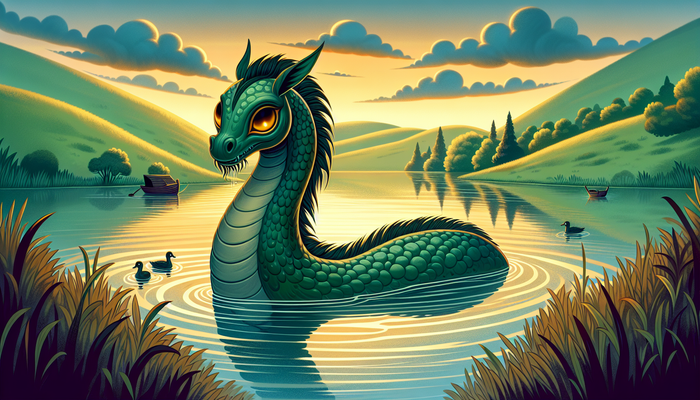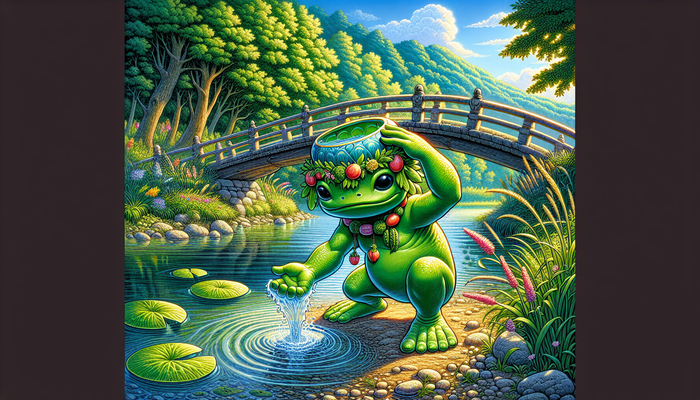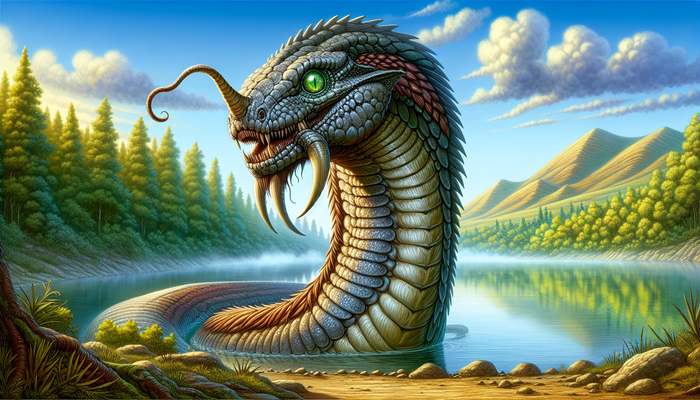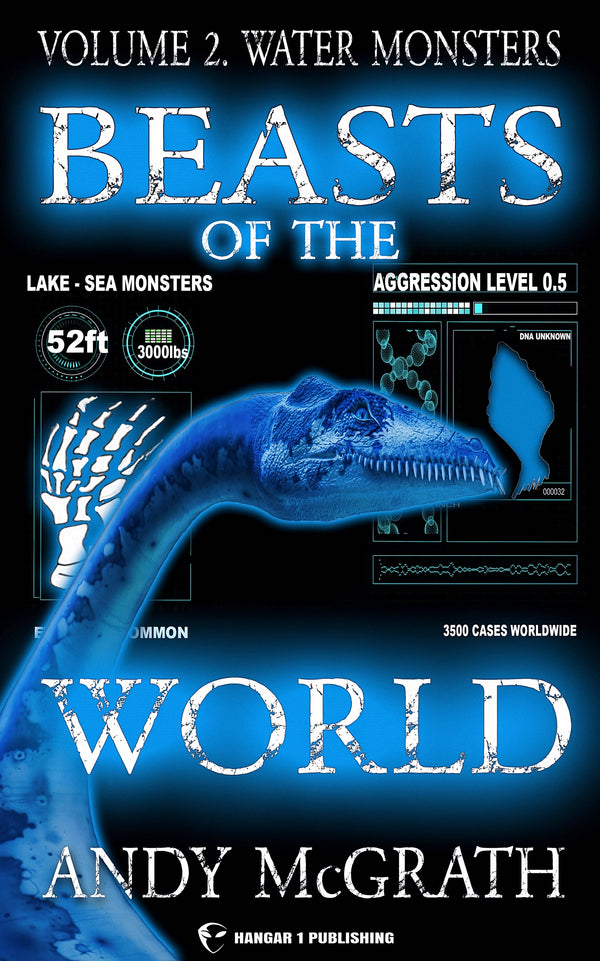The Fascinating World of the Frog Man: Myth, Culture, and Media
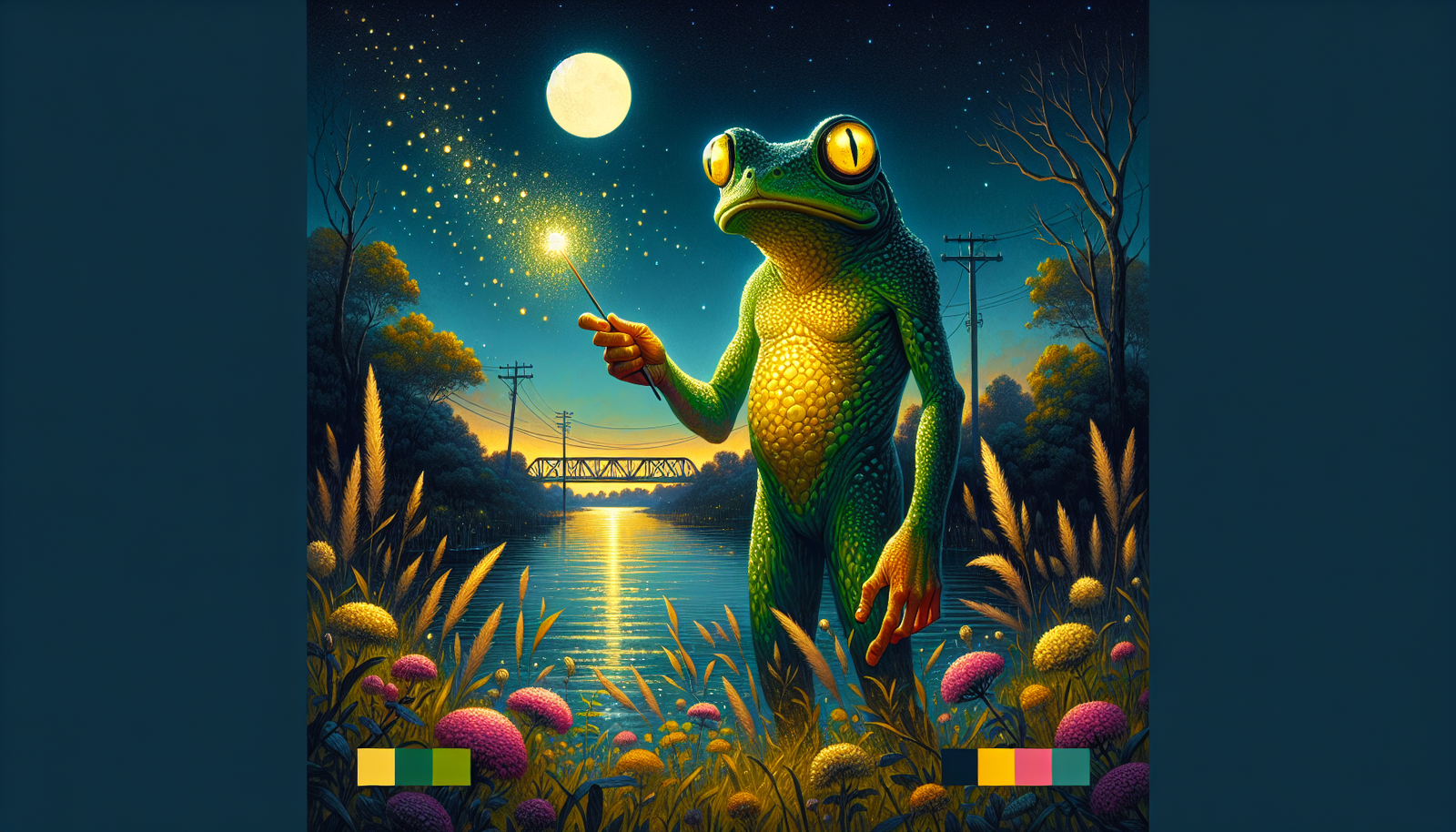
By Ava Martinez, Cryptozoologist
The Loveland Frogman: Ohio's Legendary Cryptid
Imagine a moonlit night in Loveland, Ohio, 1955. A businessman drives along a lonely road near the Little Miami River when suddenly, he spots something extraordinary. Three bizarre creatures, about four feet tall with leathery skin, crouched by the roadside. As he watches in disbelief, one of them raises a wand-like object, showering sparks into the air. This encounter marks the birth of a legend that would captivate imaginations for decades to come: the Loveland Frogman.
The Loveland Frogman isn't just another campfire tale. It's a fascinating blend of cryptozoology, local folklore, and pop culture that has left an indelible mark on the Ohio community and beyond. But the story doesn't end there. The concept of the "frog man" extends far beyond this small American town, weaving its way through global mythology, modern media, and even military history.
The 1955 sighting was just the beginning. The legend of the Loveland Frogman truly leaped into the spotlight in 1972, thanks to two police officers who had their own close encounters of the amphibious kind.
On March 3, 1972, Officer Ray Shockey was cruising down Riverside Drive near the Little Miami River when he saw something that made him slam on the brakes. There, illuminated by his headlights, was a creature straight out of a B-movie. Shockey described it as three to four feet tall, weighing about 50 to 75 pounds, with leathery skin and a frog-like face. The creature, caught in the glare of the headlights, crouched like a frog before standing upright and hopping over a guardrail, disappearing towards the river.
Just two weeks later, Officer Mark Matthews had his own run-in with what he believed to be the same creature. But this encounter took a dramatic turn. Matthews, spooked by the sight, drew his gun and fired at the mysterious being. When he approached the fallen creature, he made a startling discovery. It wasn't a frog man at all, but a large iguana missing its tail.
You'd think this revelation would put the legend to rest, right? Wrong. Despite Matthews' attempts to debunk the myth, the people of Loveland weren't ready to let go of their beloved Frogman. The legend had already taken root in the local culture, and it was here to stay.
Today, the Loveland Frogman is more than just a cryptid – it's a cultural icon. The creature has become a source of local pride, inspiring everything from t-shirts to coffee mugs. Tourists flock to Loveland, hoping to catch a glimpse of the elusive amphibian humanoid. Local businesses have embraced the legend, with frog-themed merchandise flying off the shelves faster than you can say "ribbit."
But perhaps the most delightful manifestation of Frogman fever is the bluegrass musical "Hot Damn! It's the Loveland Frog!" This toe-tapping production, which debuted at the Cincinnati Fringe Festival in 2014, tells the story of a couple searching for a missing grandfather, supposedly snatched by the Frogman. It's a perfect example of how this quirky legend has hopped its way into the heart of the community, blending local lore with good old-fashioned entertainment.
The Loveland Frogman has become more than just a mysterious creature lurking in the shadows. It's a symbol of the town's identity, a conversation starter, and a reminder that sometimes, it's the weird and wonderful stories that bring people together. Whether you're a believer or a skeptic, there's no denying the impact this amphibious anomaly has had on Loveland and beyond.
Frog Man in Popular Culture
The allure of the frog man isn't confined to the banks of the Little Miami River. This amphibious enigma has made quite a splash in popular culture, leaping from local legend to the silver screen, comic book pages, and even the pixelated worlds of video games.
The Frogman on the Silver Screen
Let's start with the silver screen. In 2023, the Loveland Frogman got its very own cinematic treatment with the release of "Frogman," a found-footage horror film that plunges viewers into the murky depths of cryptid lore. The movie follows a trio of friends – Dallas, an obsessed filmmaker determined to prove the Frogman's existence; Scotty, his long-suffering cameraman; and Amy, a friend with whom Dallas shares an unspoken romantic tension.
"Frogman" isn't your run-of-the-mill monster movie. It's a clever blend of humor and horror that plays with the absurdity of its premise while still delivering genuine scares. The film's director, Anthony Cousins, takes a page from the "Blair Witch Project" playbook, using the found-footage format to create an atmosphere of mounting dread. But where "Blair Witch" kept its monster firmly off-screen, "Frogman" isn't afraid to show its star attraction.
The creature effects in "Frogman" are a highlight, eschewing CGI in favor of practical effects that give the Frogman a tangible, slimy presence. When the creature is finally revealed in all its amphibious glory, it's a moment that will have audiences croaking with delight (or terror, depending on their disposition).
Frog-Man: The Amphibious Superhero
But the Frogman isn't the only amphibious humanoid making waves in pop culture. Comic book fans might be familiar with a certain web-slinging, lily pad-hopping hero from the Marvel Universe: Frog-Man.
Eugene Patilio, aka Frog-Man, first leaped onto the comic book scene in Marvel Team-Up #121 in 1982. Created by J.M. DeMatteis and Kerry Gammill, Eugene is the son of the villainous Leap-Frog. But instead of following in his father's criminal footsteps, Eugene decides to use his dad's frog suit for good, becoming a superhero in his own right.
Frog-Man's powers come from his suit, which is equipped with electrically-powered leaping coils in the boots. These allow him to jump great distances, though his control over these leaps is... let's say questionable. In fact, Frog-Man's clumsiness is a key part of his charm. He's not your typical graceful superhero – he's more likely to defeat villains by accidentally crashing into them than through any feat of skill.
What makes Frog-Man truly endearing is his earnest desire to do good, even if his methods are unconventional. He's teamed up with heavy hitters like Spider-Man and even joined the Avengers Initiative (though he was briefly replaced by a shape-shifting alien Skrull – it's a long story). Frog-Man represents the everyman hero, showing that you don't need to be bitten by a radioactive spider to make a difference. Sometimes, all it takes is a frog suit and a lot of heart.
Frog Men in Video Games
The frog man's influence extends into the world of video games as well. While not directly based on the Loveland Frogman, characters like Frog from the classic RPG "Chrono Trigger" show how the concept of an anthropomorphic frog can be adapted into a heroic figure. Frog, a skilled swordsman transformed into a humanoid amphibian, becomes a key ally in the player's time-traveling adventures. His character arc, dealing with themes of honor, redemption, and accepting oneself, shows how the frog man concept can be used to explore deep, universal themes.
These pop culture interpretations of the frog man – from the terrifying creature in "Frogman" to the bumbling but well-meaning Frog-Man of Marvel Comics to the noble Frog of "Chrono Trigger" – demonstrate the versatility of this concept. Whether as a source of fear, laughter, or inspiration, the frog man continues to capture our imaginations, reminding us that sometimes the most compelling characters are the ones that don't quite fit the mold.
The Frog Man in Folklore and Mythology
The concept of the frog man isn't just a modern phenomenon or a quirk of cryptozoology. It's an idea that has been hopping around human consciousness for centuries, appearing in various forms across different cultures and mythologies. From the swamps of Slavic folklore to the rice paddies of Japan, frog-like creatures have long held a special place in our collective imagination.
Slavic Mythology: The Vodyanoy
In Slavic mythology, we encounter the Vodyanoy, a water spirit often depicted as a frog-like old man covered in algae and muck. Don't let his slimy appearance fool you – the Vodyanoy is a powerful and often malevolent being. He's said to drag unsuspecting victims to his underwater palace, where they're forced to serve him for eternity. But he's not all bad – some tales portray him as a protector of fish and water creatures, punishing those who overfish or pollute his domain.
The Vodyanoy embodies the dual nature of water itself – life-giving yet potentially deadly. This duality is a common thread in frog man myths around the world. These creatures often serve as reminders of nature's power and the need for respect and balance in our relationship with the natural world.
Japanese Folklore: The Kappa
Hop over to Japan, and you'll find the Kappa, a water-dwelling yokai (supernatural creature) that's part frog, part turtle, and all mischief. With their webbed hands, scaly skin, and the distinctive water-filled bowl on top of their heads, Kappa are instantly recognizable figures in Japanese folklore. They're known for their love of cucumbers, their prowess in sumo wrestling, and their penchant for playing pranks on humans – some harmless, others decidedly less so.
But like the Vodyanoy, Kappa aren't simply monsters to be feared. They're complex figures that can be bargained with and even befriended. Many tales tell of Kappa forming bonds with humans, sharing their knowledge of medicine and irrigation. In some areas of Japan, Kappa are even venerated as water deities, with shrines built in their honor.
Frogs as Symbols of Transformation
The symbolism of the frog man goes beyond just representing the mysteries of water. Frogs themselves are powerful symbols in many cultures, often associated with transformation and rebirth due to their remarkable life cycle. A creature that begins life as a fish-like tadpole and metamorphoses into a land-dwelling adult naturally lends itself to stories of magical transformation.
This association with change and renewal is perhaps most famously represented in the fairy tale of "The Frog Prince." While not strictly a "frog man" story, it plays with similar themes – the idea of a human trapped in a frog's body, the potential for transformation, and the blurring of lines between animal and human.
Ancient Egyptian Mythology: Heqet
In ancient Egypt, we find one of the earliest examples of a frog deity in Heqet, the goddess of fertility and childbirth. Often depicted as a woman with the head of a frog, Heqet was associated with the annual flooding of the Nile, which brought life-giving water and fertile soil to the land. The connection between frogs, water, and life is clear here – frogs would appear in abundance after the floods, seemingly springing to life from the mud itself.
This link between frogs and fertility is found in many cultures. In ancient China, the frog was a symbol of Yin energy and was associated with the moon (itself linked to the feminine and fertility). Frog amulets were often used to promote fertility and safe childbirth.
The Frog Man as a Bridge Between Worlds
The frog man, in its various guises across world mythology, serves as a bridge between worlds – between water and land, between animal and human, between the mundane and the magical. These creatures remind us of our connection to the natural world and the transformative power of nature.
They also speak to our fascination with the liminal, the in-between. Frog men, neither fully human nor fully animal, embody the blurring of boundaries that often occurs in mythology and folklore. They challenge our categories and remind us that the world is often more complex and mysterious than we might like to admit.
In many ways, the modern cryptid of the Loveland Frogman is a continuation of this ancient tradition. Like its mythological predecessors, it represents the unknown lurking just beyond the edges of our everyday world. It's a reminder that even in our modern, rationalist society, there's still room for mystery and wonder.
Whether seen as fearsome monsters, mischievous tricksters, or symbols of transformation and rebirth, frog men have leapt through our stories for thousands of years. From the banks of the Nile to the shores of the Little Miami River, these amphibious anomalies continue to capture our imaginations, reminding us of the rich tapestry of myths and legends that help us make sense of our world.
The Frog Man in Modern Context
In today's world, the frog man isn't just a figure of folklore or pop culture – it's taken on new significance in light of modern environmental concerns and the digital age's impact on how we engage with myths and legends.
Environmental Significance
Frogs, with their permeable skin and dual land-water lifecycle, are often referred to as "sentinel species" – ecological indicators that can provide early warnings about environmental changes. They're particularly sensitive to pollutants and climate shifts, making them living barometers for the health of our ecosystems. In this context, the mythical frog man takes on a new role as a powerful symbol of our connection to and impact on the natural world.
The Loveland Frogman, for instance, isn't just a quirky local legend anymore. For some, it's become a mascot for conservation efforts in the Little Miami River area. After all, if a half-man, half-frog creature is supposedly living in these waters, doesn't that mean we should be doing everything we can to keep those waters clean and healthy? It's a whimsical approach to a serious issue, but one that's proven effective in raising awareness and engaging the community in environmental stewardship.
This environmental angle adds a layer of poignancy to frog man legends. As actual frog populations around the world face threats from habitat loss, pollution, and climate change, our fascination with frog men seems to reflect a deeper anxiety about our relationship with nature. Are these creatures, in some way, a manifestation of our guilt over environmental degradation? Or perhaps they represent a hope for resilience, a belief that nature will find a way to adapt and survive, even if that means evolving into something we can scarcely imagine.
The Digital Age and Cryptid Culture
But the modern era hasn't just given new meaning to old legends – it's changed how these legends spread and evolve. The rise of the internet and social media has ushered in a new golden age of cryptid culture. No longer confined to local whispers and occasional newspaper reports, stories of frog men and other mysterious creatures can now spread globally in an instant.
Platforms like Reddit, YouTube, and TikTok have become hotbeds of cryptid discussion and speculation. Amateur investigators share their theories, eyewitnesses post their accounts, and digital artists bring these creatures to life in vivid detail. The Loveland Frogman has its own hashtag on Twitter, and you can find countless videos on YouTube analyzing every aspect of the legend.
This democratization of cryptid culture has led to some interesting developments. On one hand, it's easier than ever for hoaxes and misinformation to spread. A convincingly photoshopped image can circle the globe before the truth has a chance to put its boots on. But on the other hand, this interconnectedness has allowed for unprecedented collaboration among cryptid enthusiasts. People can compare notes, cross-reference sightings, and build more comprehensive theories than ever before.
The internet has also allowed for the rapid evolution of cryptid lore. The Loveland Frogman of today isn't quite the same as the one first spotted in 1955. Details get added, the story gets embellished, and the legend grows. In some ways, this mirrors how folklore has always worked, but at a greatly accelerated pace. A single viral post can add a new wrinkle to the legend that quickly becomes "common knowledge" among enthusiasts.
The Frog Man as a Symbol of the Unknown
Perhaps the most interesting aspect of the frog man in the modern context is how it reflects our changing relationship with the unknown. In an age where we can access the sum total of human knowledge from a device in our pocket, the idea that there could still be undiscovered creatures lurking in our forests and swamps is both thrilling and comforting. It suggests that the world still has secrets to reveal, that there's still room for mystery and wonder in our lives.
The persistence of frog man legends in the face of scientific skepticism also speaks to a certain rebellion against pure rationalism. It's a reminder that not everything can be explained away, that sometimes it's okay to believe in something simply because it's a good story. In a world that often feels all too mundane, the frog man offers a splash of the extraordinary.
Moreover, our fascination with these creatures reflects a deep-seated human desire to connect with nature in a more profound way. In an increasingly urbanized world, legends of frog men and other cryptids serve as a bridge to a wilder, more mysterious natural world. They invite us to look at our surroundings with new eyes, to imagine what might be hiding just out of sight.
In this light, the modern frog man is more than just a holdover from old superstitions or a subject for campfire tales. It's a multifaceted cultural phenomenon that touches on our environmental concerns, our relationship with technology, our need for mystery, and our longing for a connection with the natural world. Whether seen as a harbinger of ecological change, a product of internet-age mythology, or simply a fun story to share, the frog man continues to make a splash in our modern world.
The Frogman in Military Context
When we hear the term "frogman," it's not always in reference to cryptids or mythological creatures. In military circles, particularly naval special operations, "frogman" takes on a whole different meaning – one that's just as fascinating and, in many ways, just as legendary as its cryptozoological counterpart.
The Origin of Military Frogmen
The term "frogman" in a military context refers to combat divers, particularly those in naval special operations units like the U.S. Navy SEALs. These elite warriors are trained to operate in the water with the same ease as a frog, hence the nickname. But how did this amphibious moniker come to be associated with some of the world's most elite soldiers?
The story goes back to World War II, a time when naval special operations were in their infancy. The term "frogman" is said to have been coined by John Spence, an enlisted member of the U.S. Navy and one of the first members of the Office of Strategic Services Maritime Unit – a precursor to the modern Navy SEALs. Spence claimed the name originated during training when someone saw him emerging from the water in his green wetsuit and exclaimed, "Hey, frogman!"
These early frogmen were pioneers in combat diving, developing techniques and equipment that would revolutionize underwater warfare. They conducted covert reconnaissance missions, planted explosives on enemy ships, and cleared obstacles from invasion beaches. Their work was dangerous, demanding, and absolutely crucial to the war effort.
Modern Military Frogmen
As naval special operations evolved, so did the role of the frogman. Today's combat divers are equipped with state-of-the-art technology that their World War II predecessors could only dream of. But the spirit of the frogman – adaptable, resilient, and at home in the harshest aquatic environments – remains the same.
The Frogman in Popular Culture
The legacy of the military frogman has left an indelible mark on popular culture. Films like "The Frogmen" (1951) and "Men of Honor" (2000) have celebrated the bravery and skill of these underwater warriors. But perhaps the most intriguing cultural artifact of frogman lore is the so-called "Frogman Ballad."
This ballad, more a spoken-word piece than a traditional song, encapsulates the ethos of the frogman in a way that's both poetic and profoundly macho. It speaks of a man who's "been around the world twice, talked to everyone once," who's "not just a lover and a fighter, but a UDT Navy SEAL diver." The ballad goes on to describe this ultimate frogman as someone who believes that "anything worth doing is worth overdoing" and who "lives life on the edge."
While the ballad might seem over-the-top to civilian ears, it reflects the intense, all-or-nothing mindset that's necessary for the extreme challenges faced by naval special operations forces. It's a testament to the frogman's willingness to push boundaries, to go beyond what's thought possible.
The Frogman as a Symbol of Human Potential
The military frogman, much like his cryptid namesake, has become a figure of legend. Stories of their exploits – some verified, others perhaps embellished – are passed down through generations of sailors and soldiers. They represent the pinnacle of human performance in one of the most unforgiving environments on Earth.
In many ways, the military frogman and the cryptid frogman aren't as different as they might seem at first glance. Both inhabit a world that's alien to most of us – the depths of the water. Both are shrouded in mystery and the subject of countless stories. And both, in their own ways, challenge our understanding of what's possible.
The military frogman shows us the heights of human achievement – what we're capable of with training, technology, and sheer determination. The cryptid frogman, on the other hand, represents the unknown, the possibility that there might be more to our world than we can explain.
Together, these two interpretations of the frogman concept speak to something fundamental in the human psyche – our fascination with pushing boundaries, exploring the unknown, and imagining what might lurk beneath the surface of our everyday world. Whether in the form of an elite warrior or a mysterious creature, the frogman continues to capture our imagination, reminding us that there's always more to discover, both in the world around us and in the depths of human potential.
Final Thoughts
As we've seen, the concept of the frog man is as varied and adaptable as the amphibians that inspired it. From the murky waters of folklore to the silver screen, from the pages of comic books to the elite ranks of military divers, the frog man has leapt across boundaries of culture, media, and imagination.
The Loveland Frogman, with its blend of local legend and cryptid lore, shows us how a simple story can become a cornerstone of community identity. It reminds us of our enduring fascination with the unknown and our ability to find wonder in our own backyards.
In popular culture, frog men have proven to be versatile characters, capable of inspiring both terror and laughter. They challenge our perceptions, blurring the lines between human and animal, hero and monster. Whether it's the campy horror of "Frogman" or the earnest bumbling of Marvel's Frog-Man, these characters reflect our complex relationship with nature and our own humanity.
The frog men of global mythology speak to universal themes of transformation, fertility, and the dual nature of water as both life-giver and potential threat. These ancient stories continue to resonate, finding new relevance in our modern world.
In the context of environmental concerns, the frog man takes on new significance as a symbol of our impact on the natural world and the need for ecological awareness. Meanwhile, the rise of internet culture has given new life to cryptid lore, allowing enthusiasts to connect and collaborate in unprecedented ways.
And in the realm of military history, the term "frogman" reminds us of the extraordinary capabilities of human beings when pushed to their limits. The legacy of these underwater warriors continues to inspire and amaze.
The enduring appeal of the frog man, in all its forms, speaks to something fundamental in the human experience. It's about our relationship with the natural world, our fascination with the unknown, and our ability to imagine possibilities beyond our everyday reality. Whether seen as a creature to be feared, a hero to be admired, or a mystery to be solved, the frog man continues to make waves in our collective imagination.
So the next time you're near a body of water, take a moment to peer into the depths. Who knows? You might just catch a glimpse of something extraordinary. After all, in the world of the frog man, anything is possible.
From Bigfoot to UFOs: Hangar 1 Publishing Has You Covered!
Explore Untold Stories: Venture into the world of UFOs, cryptids, Bigfoot, and beyond. Every story is a journey into the extraordinary.
Immersive Book Technology: Experience real videos, sights, and sounds within our books. Its not just reading; its an adventure.



